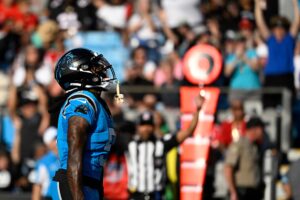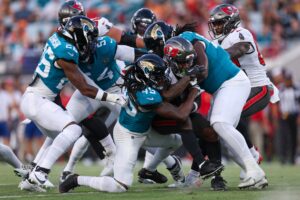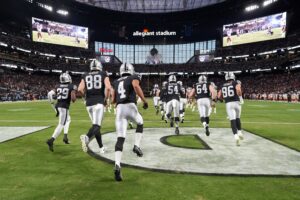Last off-season, former New York Jets general manager Mike Maccagnan pieced together a very talented backfield. He signed former Pittsburgh Steelers superstar running back Le’Veon Bell to a four-year, $52 million deal. Following a miraculous recovery for a thought to be a career-ending neck injury, veteran Bilal Powell returned on a one-year deal. Utility back Ty Montgomery was signed as Bell’s primary backup and to be Andre Roberts’ replacement as a return man. Former sixth-round pick Trenton Cannon beat out Elijah McGuire after flashing next-level speed his rookie year. On paper, the Jets 2019 depth chart looked strong and ready to be one of the better units in the league.
However, the Jets run game was abysmal in 2019. Gang Green ranked 31st in rushing yards, touchdowns and tied last with the Miami Dolphins in yards per carry. Yes, more than anything, the patchwork offensive line played a large role in the ineffective rushing attack. However, it does not change the fact Maccagnan left a mess at running back behind for Joe Douglas to clean up for 2020. The trio of Bell, Powell, and Montgomery are coming off the worst seasons of their careers. And Cannon ended the season on injured reserve. Bell has a $15 million cap hit this season. Both Powell and Montgomery are free agents. Maccagnan left behind a mess of a roster, so how exactly should Douglas be approaching fixing the running back position?
How To Fix The New York Jets Running Back Situation
-
Figure Out What Adam Gase Wants
Through his time with the Dolphins, head coach Adam Gase always used a committee backfield. The ability to filter out from power to receiving to utility backs allowed Gase to run his deep playbook. Then once the Jets signed Le’Veon Bell, his plans would need to be altered. Despite signs of a heavy rotation during the preseason, it was a different story during the regular season. Bell’s usage saw 782 snaps during the season, to Powell and Montgomery’s combined 313 snaps according to Pro Football Focus.
The bottom line is Joe Douglas will be building the team his way from now on. And given he came to the team in part because of his prior relationship with Gase, he will figure out how to work out Gase’s vision for the offense. Gase clearly struggled figuring out the best way to utilize Bell as well as adapting his committee approach to him. Thus, bringing up the question of if the Jets have the right personnel already in house.
-
Figure Out What to Do With Le’Veon Bell
Money aside, nobody can deny the skill Bell possesses. Now entering his seventh season, he has established himself as an elite runner and receiver through his patient and elusive style with the ball. His resume – three Pro Bowls, and two All-Pro teams – speak for itself.
Except the NFL is a business, and like any business, money matters. The Jets are paying the money for the production Bell provided as a Steeler. Yet Bell had multiple Pro Bowl offensive linemen blocking for him then. In 2019, the Jets had one average offensive linemen at best blocking for Bell.
Bell will be 28 years old entering the 2020 season, with 1,852 touches in his career. As much as Jets fans would love him to be back if Douglas is truly committed to building the offensive line, he will do what is right and move Bell’s contract. He certainly has a trade market, as the Houston Texans, Washington Redskins, and Philadelphia Eagles have been brought up in the past as options. It comes down to two things – is Douglas willing to part with Bell for cheap in order to get rid of his contract and if there is a team willing to take on his deal.
This will be a cloud over Bell and the Jets all off-season as Bell has become a fan favorite and leader in the locker room. In the end, it will come down to just how far Douglas is willing to go to build this team his way.
-
Free Agency: Who Stays and Who Walks
With Bell Back…
Reports came during the season of the Jets locker room becoming divided, similarly to how the Dolphins did during Gase’s time there. That being said, veteran leaders who are respected by their teammates are as important as any player. Bilal Powell is the definition of professionalism and has spent his entire nine-year career with Gang Green. Even at age 31, coming off of a serious neck injury, and with horrendous blocking, he still averaged 3.9 yards per carry – which is the worst average since his rookie season. Powell recently stated he wants to retire a Jet, and Douglas should make sure that happens.
Entering last season, Ty Montgomery was supposed to be the primary backup and heavily utilized based on his elaborate usage in the preseason. Nevertheless, Montgomery’s role faded before the season even began. He had only 45 touches all season and had a minimal impact in the return game. To bring back Montgomery to Gase’s preferred-committee approach would make no sense as he simply does not mesh into the playbook.
With Bell Gone…
With or without Bell, the Jets plan for Powell and Montgomery should remain the same. Bring back the proven and established veteran Powell and let Montgomery walk, as Trenton Cannon can simply take his spot if necessary as the kick returner.
-
Free Agency: Explore the Market… CAREFULLY!
With Bell Back…
The Jets have $56 million to spend and have significantly bigger needs than running back depth. But with the older legs of Bell and Powell, they need a pair of fresh legs. That being said, they need to take a look at cheap and reliable options. Indianapolis Colts’ free-agent Jonathan Williams proved to be a strong power back in a limited role when Marlon Mack was hurt. Spencer Ware or CJ Prosise both have injury riddled-pasts, yet have shown enough flashes of talent to deserve another shot. The Jets easily could take on one for cheap.
With Bell Gone…
With Bell being traded, or released, at least the Jets must look towards free agency for an established starter. There is no way Douglas opens the checkbook for a Derrick Henry or Melvin Gordon, especially having just gotten rid of Bell.
Philadelphia Eagles running back Jordan Howard will be high on the Jets wish list in free agency. He was acquired by the Eagles while Douglas was in charge of player personnel, so there is a past connection. Howard would be relatively cheap and be able to be the main back.
Lamar Miller could also be an intriguing option. Coming off of a torn ACL, Miller will be 29 next season, but had his best seasons with Gase in Miami. A reunion would not be expensive and might make sense for both parties. Either way, a Jets backfield without Bell would mean the Jets have to spend a draft pick on the running back position.
-
Draft the Future
Speaking of fresh legs, chances are a Bell trade will bring in a middle round draft pick in return. It is more than likely that pick will be used then on his replacement. Luckily, there are plenty of day one starters in this year’s draft.
At 5’11” and 212 pounds, Florida State back Cam Akers has the size, power, and athleticism to become a number one back right away. Likely a day two pick, Akers flashed his potential in college but never reached his ceiling due to horrendous offensive line play. Sound familiar? With a better offensive line, Akers can burst onto the season right away for the Jets.
Joining Akers as day two candidates are Arizona State’s Eno Benjamin and Vanderbilt’s Ke’Shawn Vaughn. Benjamin stands on the smaller side at 5’9″ and 195 pounds, but where he lacks in speed and elusiveness, he makes up for through his patience and vision. The same goes for Vaughn. At 5-10 and 205 lbs., Vaughn is a physical power back who will hit the hole and fight for extra yards. More of a two-down back, Vaughn is the definition of a downhill runner who would do well running in inside zones.
Looking more at borderline third through fifth-round prospects, there is still great talent available. Florida’s Lamical Perine would be a great rotation back with an aggressive running style despite limited power. Memphis’ Antonio Gibson continues to rise up boards as a running back/wide receiver hybrid. At 6-2 and 220 lbs., Gase would love to be able to move Gibson around to both position, and not to mention Gibson is explosive in open space even at his size. Joshua Kelley from UCLA and Patrick Taylor Jr., also from Memphis, are more traditional power backs who bring solid value on day three.
-
No Man Is Safe (Except Possibly Bell)
With committee backfields, anybody can be the lead back anytime. That being said, between different skill sets, workloads, and injury history, nobody is a lock on the roster. And that is exactly how the Jets should look at the unit IF Le’Veon Bell is gone.
For the 2020 season, Bilal Powell will be 32, and he just had a thought-to-be career-ending neck injury a little over a year ago. Trenton Cannon has never established himself as an NFL-caliber runner, despite his elite speed. Whoever comes to the Jets through free agency will likely be on a cheap contract in case of potential injury or poor production. Moreover, who is to say their draft pick will be able to step in immediately to become the lead back for Gang Green. The running back position’s production will be too vital to Sam Darnold’s third season success to have as one of the worst in the league for a third straight year.
Last Word on How to Fix the New York Jets Running Back Situation
Nobody knows for a fact if Le’Veon Bell will be a Jet in 2020 or not. Trade or no trade, the Jets must approach the position the same – get younger and build for more committee-based usage. Bilal Powell has earned his tenth season and should be joined by young backs in free agency and the draft. No matter what happens with Bell, Joe Douglas has a lot of work ahead of him, as he knows how vital the success of the run game will be in 2020.






